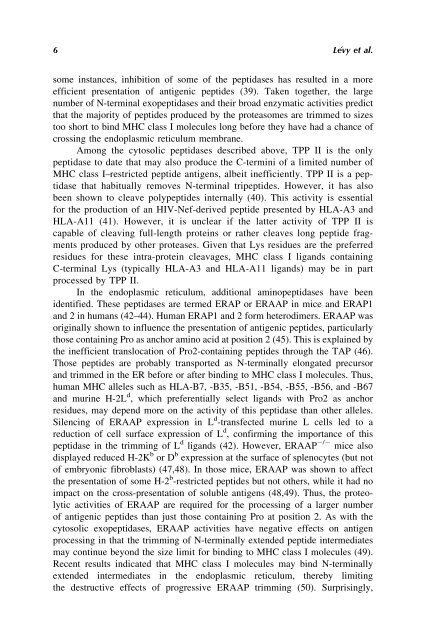Download File - JOHN J. HADDAD, Ph.D.
Download File - JOHN J. HADDAD, Ph.D.
Download File - JOHN J. HADDAD, Ph.D.
You also want an ePaper? Increase the reach of your titles
YUMPU automatically turns print PDFs into web optimized ePapers that Google loves.
6 Lévy et al.<br />
some instances, inhibition of some of the peptidases has resulted in a more<br />
efficient presentation of antigenic peptides (39). Taken together, the large<br />
number of N-terminal exopeptidases and their broad enzymatic activities predict<br />
that the majority of peptides produced by the proteasomes are trimmed to sizes<br />
too short to bind MHC class I molecules long before they have had a chance of<br />
crossing the endoplasmic reticulum membrane.<br />
Among the cytosolic peptidases described above, TPP II is the only<br />
peptidase to date that may also produce the C-termini of a limited number of<br />
MHC class I–restricted peptide antigens, albeit inefficiently. TPP II is a peptidase<br />
that habitually removes N-terminal tripeptides. However, it has also<br />
been shown to cleave polypeptides internally (40). This activity is essential<br />
for the production of an HIV-Nef-derived peptide presented by HLA-A3 and<br />
HLA-A11 (41). However, it is unclear if the latter activity of TPP II is<br />
capable of cleaving full-length proteins or rather cleaves long peptide fragments<br />
produced by other proteases. Given that Lys residues are the preferred<br />
residues for these intra-protein cleavages, MHC class I ligands containing<br />
C-terminal Lys (typically HLA-A3 and HLA-A11 ligands) may be in part<br />
processed by TPP II.<br />
In the endoplasmic reticulum, additional aminopeptidases have been<br />
identified. These peptidases are termed ERAP or ERAAP in mice and ERAP1<br />
and 2 in humans (42–44). Human ERAP1 and 2 form heterodimers. ERAAP was<br />
originally shown to influence the presentation of antigenic peptides, particularly<br />
those containing Pro as anchor amino acid at position 2 (45). This is explained by<br />
the inefficient translocation of Pro2-containing peptides through the TAP (46).<br />
Those peptides are probably transported as N-terminally elongated precursor<br />
and trimmed in the ER before or after binding to MHC class I molecules. Thus,<br />
human MHC alleles such as HLA-B7, -B35, -B51, -B54, -B55, -B56, and -B67<br />
and murine H-2L d , which preferentially select ligands with Pro2 as anchor<br />
residues, may depend more on the activity of this peptidase than other alleles.<br />
Silencing of ERAAP expression in L d -transfected murine L cells led to a<br />
reduction of cell surface expression of L d , confirming the importance of this<br />
peptidase in the trimming of L d ligands (42). However, ERAAP / mice also<br />
displayed reduced H-2K b or D b expression at the surface of splenocytes (but not<br />
of embryonic fibroblasts) (47,48). In those mice, ERAAP was shown to affect<br />
the presentation of some H-2 b -restricted peptides but not others, while it had no<br />
impact on the cross-presentation of soluble antigens (48,49). Thus, the proteolytic<br />
activities of ERAAP are required for the processing of a larger number<br />
of antigenic peptides than just those containing Pro at position 2. As with the<br />
cytosolic exopeptidases, ERAAP activities have negative effects on antigen<br />
processing in that the trimming of N-terminally extended peptide intermediates<br />
may continue beyond the size limit for binding to MHC class I molecules (49).<br />
Recent results indicated that MHC class I molecules may bind N-terminally<br />
extended intermediates in the endoplasmic reticulum, thereby limiting<br />
the destructive effects of progressive ERAAP trimming (50). Surprisingly,

















